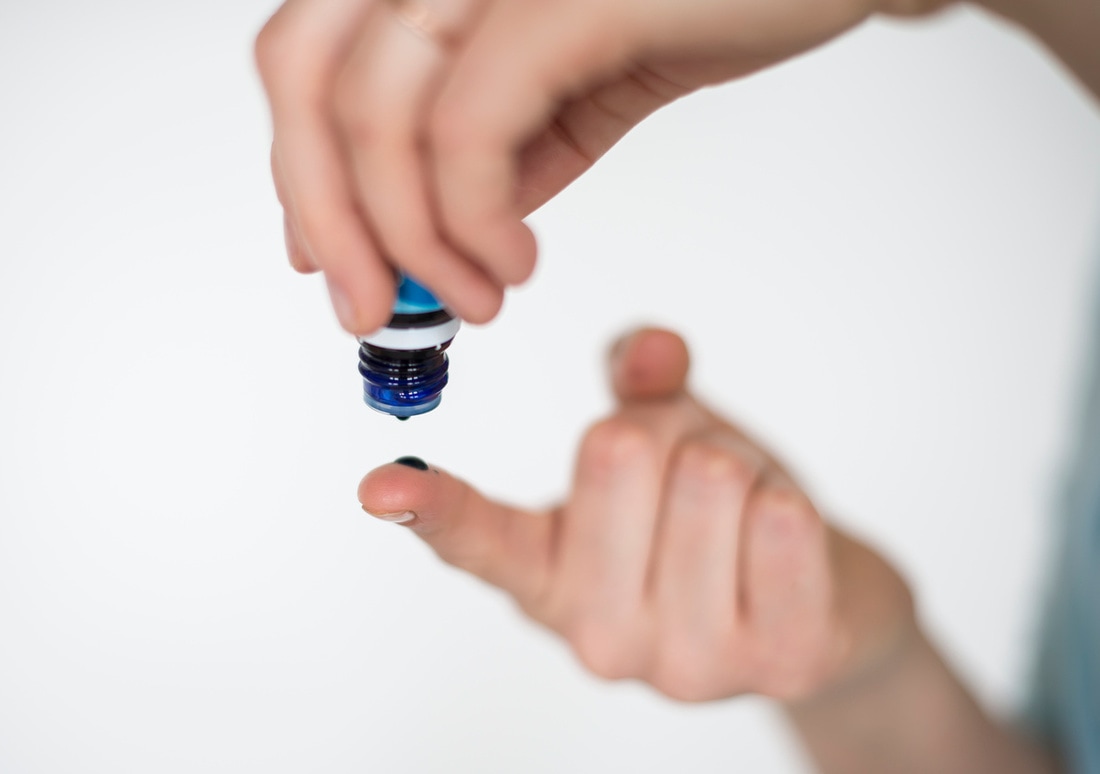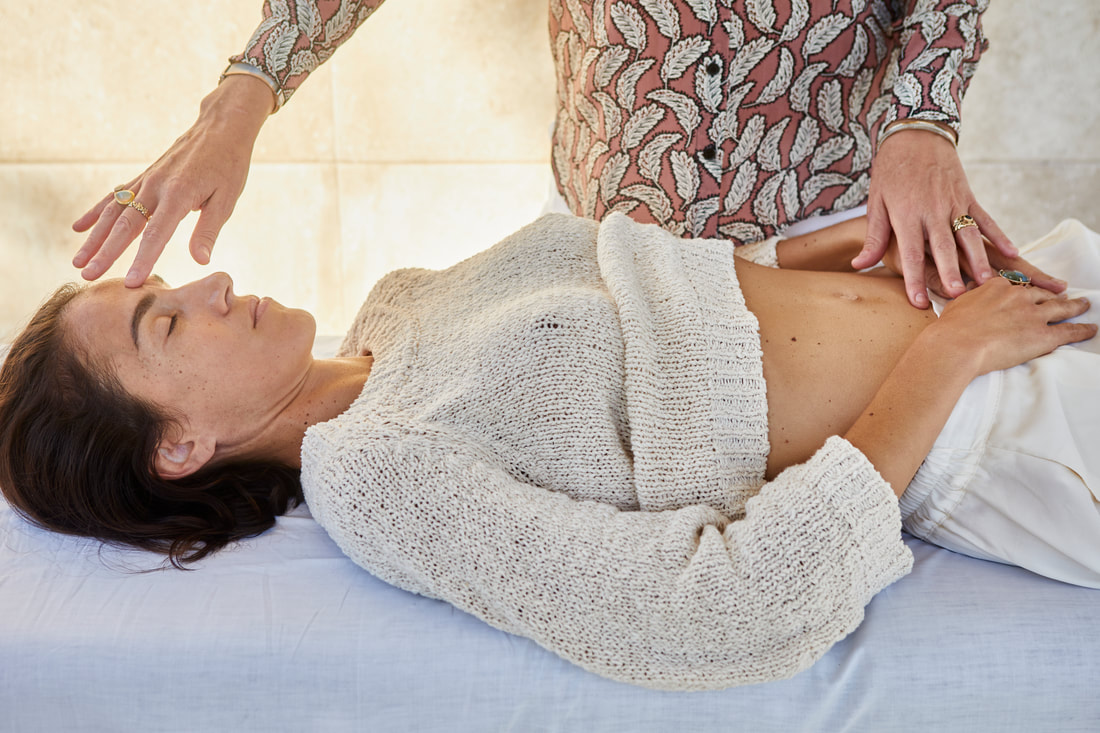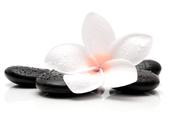What is Aroma Point Therapy and How Does it Work?
Aroma Point Therapies, or APT, refers to a collection of works that combines the healing potency of essential oils with specific acupoints or body zones in order to catalyze profound shifts in the body, mind and spirit. It is a gentle, completely safe and yet exceptionally effective healing modality that engages the energetic potential hidden within essential oils; the vehicles of the plant spirits and particular plant Medicine.
The practice itself involves placing key, properly diluted oils on specific acupoints, chakras or reflex zones on the body in order to activate energetic and physiological changes. These shifts are part of a cascade of events that unfold both in linear and non-linear realities, and they foster the establishment and "remembering" of dynamic equilibrium and authentic naturalness on all levels of being.
In pairing key essential oils with specific points and energy centers we're able to access the profound power generated in mutual resonance. The Medicine of resonance is crucial in these times of extraordinary complexity in our dysfunctions and disease states. It is also essential in building and co-creating empowerment pathways within health care.
The simple elegance of this transformative technique, which is paired with an understanding and ability to assess energetic states, is an absolutely brilliant companion to any healing arts practice. Whether you are an Acupuncturist, Body Worker, Energy Worker, Nurse, Physical Therapist, Therapist, Occupational Therapist, or an "everyday healer" in your home and community... you and your clients and loved ones will benefit magnificently!
HOW AROMA POINT THERAPIES WORK
Article written by Peter Holmes and Tiffany Carole Pollard
* You will see the term "Aroma Acupoint Therapy" throughout this article. AAT is a technique with specific protocols and diagnostic system that was originally co-created by Tiffany Carole Pollard and Peter Holmes, beginning in 2011. While Mr. Holmes and Tiffany Carole no longer teach this system together, their individual works continue and were influenced by one other. Their current seminars and workshops no longer contain the exact protocols in the original works entitled "Aroma Acupoint Therapy."
How does Aroma Acupoint Therapy work? The basic premise is that essential oils, being energetically just as active as acupuncture points, have the ability to stimulate the points in a similar way as needles. However, the difference between them lies in the fact that unlike acupuncture needles, essential oils are also able to provide a content of information to the point that will suggest a particular type of therapeutic action. The basic aim is always to select an oil that possesses the same function as an acupoint; an oil that will activate a particular point function. So Geranium oil (Pelargonim x asperum), for instance, is a female hormonal regulator in women with reproductive weakness that is a perfect match for points such as SP-6 and CV-4, as these poins have the same function. However, Geranium is also a mucostatic agent that has the effect of helping dry up vaginal discharges, and as such is appropriate for application onto points such as CV-6 and SP-10 in women with a damp or congestive condition in the pelvis.
Conversely, because each acupoint has more than one action, there a several oils that could potentially be used with it, as the situation would demand it. An important acupoint such as CV-17 at the center of the chest can be oiled with a nervous sedative oil such as Marjoram (Origanum maiorana) or Helichrysum (Helichrysum angustifolium), as this point has a good calming effect on the whole system. It is often used in states of acute anxiety and agitation, especially when there is an emotional component present. Equally however, CV-17 can be oiled with respiratory restoratives and stimulants such as Siberian fir (Abies sibirica) and Black spruce (Picea mariana) to enhance the point’s excellent tonifying and strengthening effect on the lungs and bronchi. This type of combination is highly beneficial, for instance, in individuals with constitutional lung weakness, in chronic respiratory infections or for states of grief; these are all conditions where lung energy is weakened and will benefit from this powerful oil-point synergy. In all these cases, the essential oil is able to effectively and safely engage and amplify a particular acupoint function.
The mechanism of action at work here is unproven, as Aroma Acupoint Therapy is a very new treatment modality. Still, there are several theories that would help explain the bodymind’s often immediate response to oil-point treatment as well as this therapy’s longterm effectiveness. One is that the oils are able to activate peptides connected with the points that through the meridian energy pathways transmit the suggested action to specific target tissues, organs, and so on. The simplest explanation, however, is the universal principle of reciprocal resonance. Oils and points possessing a similar quality and function will energetically resonate with each other and create a particular sonic vibration. This would be the same as the sound created when a peptide docks into a receptor site. This is essentially how a therapeutic effect is achieved.
THE FRAGRANCE ENERGETICS OF ESSENTIAL OILS
The basic framework for the use of essential oils in Aroma Acupoint Therapy is a clinical, empirical model of the energetic properties of essential oils based on their aromatic or fragrance qualities. The oils are broadly divided into high, middle and base tones, corresponding to their rising, circulating and sinking energetic movements, respectively. Within these lie the specific categories of their aroma qualities, such as Pungent-Fresh, Pungent-Spicy, Green-Sweet, Green-Lemony, and so on. So Rosemary oil (Rosmarinus officinalis), for instance, is a Fresh-Pungent oil with secondary Sweet and Green qualities. Every aroma category has specific energetic and functional properties that all oils belonging to it have in common. So Fresh-Pungent oils are generally stimulating, energizing, uplifting, awakening and warming. They are used in weak, cold and damp conditions with their typical symptoms of fatigue, cold extremities, etc. (see also below). Roman camomile (Anthemis nobilis), for another example, belongs to the Green-Sweet oil aroma category and is usually chosen for its cooling, relaxing, pain-relieving and centering effects that are typical of this category. Within an oil’s group function then lies its own separate functions, which span specific physiological actions, psychological functions through to spiritual functions. Any of these may be engaged during treatment.
THE TREATMENT SEQUENCES
Aroma Acupoint treatment consists of just one or two drops of an essential oil being lightly applied to the acupoint with a finger or cotton swab and held in place for a short amount of time. The practitioner will select one or more treatment sequences or patterns that typically involve activating between three and eight points. In the context of bodywork, this may be followed and/or introduced by massage, deep tissue work, etc. In the context of acupuncture, this may be optionally followed by needling the points. Although Aroma Acupoint Therapy lends itself beautifully to being used alongside these other types of treatment, it does not rely on these for its effectiveness and successfully stands alone as a method of treatment. The practitioner will choose to perform one or more treatment sequence per session. These are named after the most prominent symptom in the pattern, e.g. Racing Mind, Neck and Shoulder Tension, PMS with Heat, Emotional Withdrawal, and so on. They are organized according to an underlying syndrome of energetic or functional imbalance. The treatment sequences are specific to modern-day patients, their health concerns and their frank disorders. They are particular to what we actually see in the Western clinic day in and day out. Once the practitioner gains greater experience and comfort levels with the treament patterns, she will know when to modify the pattern to give a more individualized, client-tailored treatment. On the basis of increased knowledge of the oils on one hand and the acupoints on the other, she may select other point-oil combinations appropriate to the treatment.
Evaluating the symptoms the client presents is performed using the Six Condition diagnostic assessment, a user-friendly diagnostic system that Peter developed over many years of practice and research into the diagnostics of traditional Chinese, Greek and Ayurvedic medicine – the three extant world systems of energetic medicine. The symptoms may be mental, emotional or purely physical and form syndromes of energetic imbalance. The main axis of imbalance seen in our society is the axis of the Tense-Weak conditions, which is based on hyper- and hypo- functioning of the nervous system, respectively. Commonly seen as well, however, are symptoms of imbalance between the Hot-Cold axis, based on hyper- and hypo- functioning of the body’s warmth-circulatory system; and the Dry-Damp axis, based on tissue hydration and fluid balance.
The symptom evaluation itself includes not only what the client reports but also an assessment of her facial complexion, skin quality, muscle tone, breathing, voice, pulse quality, physical movement, likes and dislikes as regards food, drink, climate, and so on. These all together tell the practitioner the nature of the imbalance in terms of the Six Conditions and will point to possible treatment patterns. Once treatment is underway, the practitioner will monitor its effectiveness by looking for positive signs of change in the client’s complexion, their brightness of the eyes, sound of the voice and improvement of the pulse quality, as well as improvement of actual symptoms. It is not unusual to find improvement in all of these diagnostic parameters by the end of a successful treatment and, in some cases, very soon after all the oils have been placed. The pulse in particular can respond very quickly to the rebalancing effect of oils applied to a judicious selection of points. This is because the pulse registers the functional changes taking place in the vascular autonomic system.
ORIGIN
The origins of Aroma Acupoint Therapy go back to Peter’s acupuncture practice in the 1980s when he became involved with Aromatherapy as it developed in England at that time. Realizing that essential oils were just as electromagnetically powerful as acupuncture needles, he began experimenting on patients by placing a drop of oil on a point instead of stimulating it with a needle. Many years of experimentation and observation then led Peter to develop the experiential model of aroma energetics for the essential oils described above (Fragrance Energetics). Since the early 1990s this model has formed the foundation for understanding the inner or energetic nature of essential oils and their effects on body, mind and soul. It is the cornerstone today of the energetic approach to using the oils in Aroma Acupoint Therapy.
In 2010, Tiffany and Peter began an intensive process of collaboration and evaluation, in which Tiffany put the theory, models and emerging ideas into daily clinical practice; treating up to 17 patients per day with these techniques. This intensive, ongoing exploration of the clinical actions of essential oils rapidly generated a large pool of clinical experience that eventually led to the creation of the first Aroma Acupoint Therapy workshop in September 2011.
CLINICAL EXAMPLES FROM TIFFANY CAROLE POLLARD'S PRACTICE
AAT is hands down my most valuable tool in clinical practice. Treating hundreds of patients per month has served to validate on an ongoing basis the effectiveness of this powerful modality. I would like to provide you with just a few examples of how I use the essential oils in my day-to-day work with patients.
Let’s look at Saro oil (Cinnamosma fragrans) first. This opening and lifting high tone oil falls into the Fresh-Pungent category and as such we see that it pairs well energetically with acupuncture points on the upper part of the body. In addition it has a particular affinity for the Lung meridian. We have several sequences in AAT that maximize the effects of this oil in treatment. But generally speaking I often pair Saro with the acupoint LU-1 in order to resolve grief, dissolve a sense of disconnection to life, rekindle inspiration, and open one to receive. I pair this with Blue Tansy (Tana- cetum annuum) on LIV-14 to open the diaphragm and facilitate the reconnection of aspiration to inspiration. This is a profound treatment that can help people see beyond obstacles (often times this shows up in our ways of thinking), and move forward propelled by renewed hope. Blue tansy is another oil that I use almost daily in my practice. This is a middle tone oil with a wonderful Sweet-Green aromatic quality. It has the ability to both harmonize and move stagnation, particularly as it relates to the Liver meridian. Applying Blue Tansy to LIV-3 and GB-34 is commonplace in my clinic. We see that this oilto-point combination helps resolve stuck anger, smoothe one through frustration, encourage flexibility in life and resolve pain caused by stagnation and inflammation.
An oil from the Woody and Rooty category I want to highlight is Vetiver (Vetive- ria zizanioides). This viscous and grounding oil, when paired with the right acupoints, has the power to clear heat from the upper body (including hot flashes and night sweats) and stabilize symptoms such as anxiety with ungroundedness, an inability to focus and insomnia with a racing mind. Foot and ankle points pair best with Vetiver, and the combinations I use most frequently include use of K-1, 5 or 6, BL-60 and GB-41.
AAT opens up an entire world of treatment possibilities by engaging the energetic functionality of the EO’s together with the potency and potentiality of the acupuncture points. Practitioners who study AAT report that they are able to go into the clinic the day after a workshop and begin seeing profound results right away! The diagnostic understanding of the Six Conditions, paired with knowledge of Aroma Energetics allows essential oils to be potent, non-invasive treatment allies. And as a gratifying bonus, patients generally love the aromatherapy they receive!
To find out about current workshops offered, please click here.
To read more about Tiffany Carole Pollard , please click here


